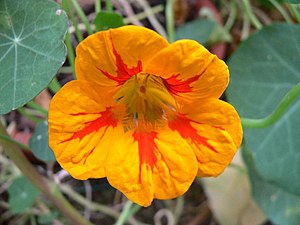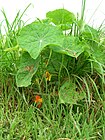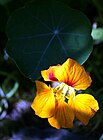Note: This is a project under development. The articles on this wiki are just being initiated and broadly incomplete. You can Help creating new pages.
Tropaeolum majus
Nasturtium is an annual to short-lived perennial plant. It can vary in habit from a dwarf plant growing only 30cm tall, to a climbing plant with stems up to 3.5 metres long. The stems scramble over the ground and into the surrounding vegetation, supporting themselves by twisting their leaf stalks around the plants.
Contents
[hide]- 1 Uses
- 2 Parts Used
- 3 Chemical Composition
- 4 Common names
- 5 Properties
- 6 Habit
- 7 Identification
- 8 List of Ayurvedic medicine in which the herb is used
- 9 Where to get the saplings
- 10 Mode of Propagation
- 11 How to plant/cultivate
- 12 Commonly seen growing in areas
- 13 Photo Gallery
- 14 References
- 15 External Links
Uses
Bronchial catarrh, Genito-urinary diseases, Respiratory infections, Scurvy, Poor skin, Baldness, Minor injuries, Skin eruptions.[1]
Parts Used
Leaves, Flowers, Young seed pods, Seeds.
Chemical Composition
Nine components representing 92.0 % of the essential oil total (GC/FID chromatogram) were identified. The most abundant compounds were benzyl isothiocyanate (82.5 %), benzene acetonitrile (3.9 %) and 2-phenylethyl isovalerate (2.9 %).[2]
Common names
| Language | Common name |
|---|---|
| Kannada | |
| Hindi | |
| Malayalam | |
| Tamil | |
| Telugu | |
| Marathi | |
| Gujarathi | |
| Punjabi | |
| Kashmiri | |
| Sanskrit | |
| English | Garden nasturtium, Indian cress |
Properties
Reference: Dravya - Substance, Rasa - Taste, Guna - Qualities, Veerya - Potency, Vipaka - Post-digesion effect, Karma - Pharmacological activity, Prabhava - Therepeutics.
Dravya
Rasa
Guna
Veerya
Vipaka
Karma
Prabhava
Habit
Identification
Leaf
| Kind | Shape | Feature |
|---|---|---|
Flower
| Type | Size | Color and composition | Stamen | More information |
|---|---|---|---|---|
| {{{5}}} |
Fruit
| Type | Size | Mass | Appearance | Seeds | More information |
|---|---|---|---|---|---|
Other features
List of Ayurvedic medicine in which the herb is used
Where to get the saplings
Mode of Propagation
How to plant/cultivate
A plant of the tropics, it can be cultivated as an annual in the temperate zone.[4]
Commonly seen growing in areas
Disturbed areas, Coastal areas.
Photo Gallery
References
- Jump up ↑ Indian Medicinal Plants by C.P.Khare
- Jump up ↑ Chemical constituents
- Jump up ↑ [Morphology]
- Jump up ↑ Cultivation
External Links
- Ayurvedic Herbs known to be helpful to treat Bronchial catarrh
- Ayurvedic Herbs known to be helpful to treat Genito-urinary diseases
- Ayurvedic Herbs known to be helpful to treat Respiratory infections
- Ayurvedic Herbs known to be helpful to treat Scurvy
- Ayurvedic Herbs known to be helpful to treat Poor skin
- Ayurvedic Herbs known to be helpful to treat Baldness
- Ayurvedic Herbs known to be helpful to treat Minor injuries
- Ayurvedic Herbs known to be helpful to treat Skin eruptions
- Herbs with Leaves used in medicine
- Herbs with Flowers used in medicine
- Herbs with Young seed pods used in medicine
- Herbs with Seeds used in medicine
- Herbs with common name in English
- Habit - Perennial
- Index of Plants which can be propagated by Seeds
- Herbs that are commonly seen in the region of Disturbed areas
- Herbs that are commonly seen in the region of Coastal areas
- Herbs








